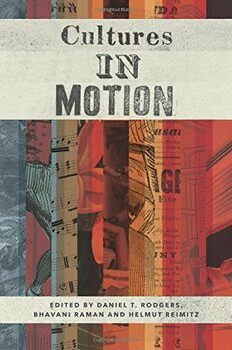
Cultures in Motion PDF
Preview Cultures in Motion
Cultures in Motion PUBLICATIONS IN PARTNERSHIP WITH THE SHELBY CULLOM DAVIS CENTER AT PRINCETON UNIVERSITY Daniel T. Rodgers, Bhavani Raman, and Helmut Reimitz, eds., Cultures in Motion Cultures in Motion Edited by Daniel T. Rodgers, Bhavani Raman, and Helmut Reimitz P r i n c e to n U n i v e rs i t y P r e s s Princeton and Oxford Copyright © 2014 by Princeton University Press Published by Princeton University Press, 41 William Street, Princeton, New Jersey 08540 In the United Kingdom: Princeton University Press, 6 Oxford Street, Woodstock, Oxfordshire OX20 1TW press.princeton.edu Jacket art from left to right: Men and women dancing, from Charles Dickens’ American Notes, courtesy of April Masten. Specimens of theatrical cuts, courtesy of the Harvard Theatre Collection. Sheet Music, “Camp Town Hornpipe, as danced by Master Diamond,” courtesy of the American Antiquarian Society. Alcoa Steamship Co. ad, Holiday, April 1951, courtesy of Mimi Sheller. William Sydney Mount, Dance of the Haymakers, courtesy of The Long Island Museum of American Art, History, & Carriages; gift of Mr. and Mrs. Ward Melville, 1950. Image of Master Juba, Illustrated London News, August 5, 1848, and detail from National Theatre playbill, Boston, July 5, 1840, courtesy of the Harvard Theatre Collection. ALCOA aluminum ad, “Peer into the Future,” and Bohn ad, Fortune, ca. 1943, courtesy of Mimi Sheller. All Rights Reserved ISBN 978-0-691-15909-6 Library of Congress Control Number: 2013949385 British Library Cataloging-in-Publication Data is available This book has been composed in Sabon LT Std Printed on acid- free paper. ∞ Printed in the United States of America 10 9 8 7 6 5 4 3 2 1 Contents Acknowledgments vii Cultures in Motion: An Introduction Daniel T. Rodgers 1 Part I: The Circulation of Cultural Practices 21 Chapter One: The Challenge Dance: Black- Irish Exchange in Antebellum America April F. Masten 23 Chapter Two: Musical Itinerancy in a World of Nations: Germany, Its Music, and Its Musicians Celia Applegate 60 Chapter Three: From Patriae Amator to Amator Pauperum and Back Again: Social Imagination and Social Change in the West between Late Antiquity and the Early Middle Ages, ca. 300– 600 Peter Brown 87 Part II: Objects in Transit 107 Chapter Four: Knowledge in Motion: Following Itineraries of Matter in the Early Modern World Pamela H. Smith 109 Chapter Five: Fashioning a Market: The Singer Sewing Machine in Colonial Lanka Nira Wickramasinghe 134 Chapter Six: Speed Metal, Slow Tropics, Cold War: Alcoa in the Caribbean Mimi Sheller 165 Part III: Translations 195 Chapter Seven: The True Story of Ah Jake: Language, Labor, and Justice in Late- Nineteenth- Century Sierra County, California Mae M. Ngai 197 vi • Contents Chapter Eight: Creative Misunderstandings: Chinese Medicine in Seventeenth- Century Europe Harold J. Cook 215 Chapter Nine: Transnational Feminism: Event, Temporality, and Performance at the 1975 International Women’s Year Conference Jocelyn Olcott 241 Afterwords 267–278 Itinerancy and Power Bhavani Raman 267 From Cultures to Cultural Practices and Back Again Helmut Reimitz 270 List of Papers 279 List of Contributors 283 Notes 285 Index 357 Acknowledgments This volume grew out of seminars and colloquia organized by the Shelby Cullom Davis Center for Historical Studies at Princeton Univer- sity under its program from 2008 to 2010 titled “Cultures and Institu- tions in Motion.” Since 1968 the center has undertaken the exploration of topics at the cutting edge of the historical profession. At the weekly Davis Seminar, the center’s selected resident fellows join with faculty and graduate students in intensive discussion of a broad, preselected theme. The starting points for the discussions involving the authors of this volume were the new global and transnational histories that have so pro- foundly reshaped historical practice in recent times. Related to the cur- rent experience of globalization but reaching back deep into the past, these inquiries have begun to map worlds in which ideas, institutions, ob- jects, and practices were in constant motion across social and geographic space. Taken together, they challenge the premise of stable, functionally integrated cultural systems that has long been core to the historical pro- fession. They describe worlds of trespass, boundary crossing, itinerancy, translation, and exchange that historians are just beginning to plumb. The essays assembled here represent only a fraction of the four dozen papers presented by the center’s resident fellows and others over the course of these two years. Each sparked vigorous and wide-r anging dis- cussion of the sort for which the Davis Seminar has long been known. A full list of papers is appended. To all those who presented their work to the seminar, with a richness that we can only partially tap here, we are extremely grateful. We are grateful, too, to the seminar participants— fellows, faculty members, graduate students, discussants, and others— who week by week tackled these issues, pressed our theme of “Cultures in Motion” forward, and probed its depths and complexities. Not the least we are grateful to the resident fellows, whose intellectual energy, in- quisitiveness, and comradeship reverberated all through Dickinson Hall. The Davis Center’s manager, Jennifer Houle Goldman, deserves par- ticular thanks for her efficient and gracious management of the center and the well-b eing of its fellows. Sarah Brooks edited the initial drafts of these essays with intelligence and care. At Princeton University Press, Peter Dougherty, director, Brigitta van Rheinberg, editor in chief, Larissa Klein, and Jenny Wolkowicki have been staunch supporters of the cen- ter’s work and publishing projects. Daniel T. Rodgers, Bhavani Raman, and Helmut Reimitz, Editors Cultures in Motion
